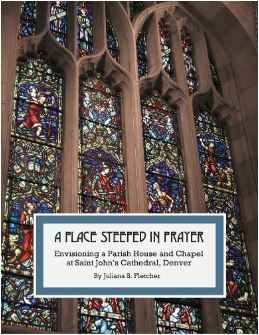Story
Steeped in Prayer
A review of Juliana S. Fletcher's 2022 release, A Place Steeped in Prayer: Envisioning a Parish House and Chapel at Saint John’s Cathedral, Denver.
Editor's note: This review comes to you from the Colorado Book Review. More reviews can be found at the Denver Public Library.
A Place Steeped in Prayer is not only a beautifully illustrated tour of two of the most beautiful buildings on the campus of St. John’s Cathedral—Dagwell Parish Hall and Saint Martin’s Chapel—but also a detailed account of the dedicated vision and accomplishments of clergy, laymen, and artists and architects, set against the background of vibrant moments of Denver history.

A Place Steeped in Prayer: Envisioning a Parish House and Chapel at Saint John’s Cathedral, Denver by Juliana S. Fletcher.
From its first service, held in a dirt-floored cabin in 1860, the Church of St. John’s in the Wilderness gradually grew into a block-long campus centered on a magnificent 1911 Gothic Revival cathedral. In the early 1920s, the need for additional facilities became obvious to Benjamin Dagwell, the cathedral’s third dean. In 1926, working with the newly formed Church Art Commission, the dean commissioned architects and artists to design, build, and furnish Saint John’s Parish House and a children’s chapel.
The first part of the book, “It Is Both Imperative and Possible—The Parish House,” includes images of the dean’s eloquent appeal for funding, and a brochure outlining every aspect of the proposed new parish house. It then continues with page after page of images of the brilliant stained glass, ceramic tiles, and other architectural details still to be seen in this historic building.
A second section, “We Have Seen His Glory—St. Martin’s Chapel,” begins with the history of Saint Martin and the legend of his cloak being shared with a needy man, and then takes the reader around the interior of this beautiful chapel. Vibrant photographs and clear descriptions reveal the magnificent carved oak reredos, the glorious stained-glass windows, the glowing painted images on the arched ceiling, and the intricate wood carvings on pews and walls.
The chapel, described by author Juliana Fletcher as “an exceptionally beautiful example of the Arts and Crafts period design” (p. 6), was created by an inspired group of architects and internationally known artists. Throughout the book, carefully researched, well-written, and enlightening biographies provide a wealth of information about the men—and women—responsible for this sacred place of prayer. Included in these are Burnham Hoyt, resident architect for St. John’s Cathedral, whose Denver firm was chosen to design the buildings. Hoyt not only designed many famous Denver buildings, but also created the interior of Riverside Church in New York, and Denver’s famous Red Rocks Amphitheatre. Other internationally known artists, such as Arnold Ronnebeck, John Thompson, and Paul St. Gaudens are included, as well as the welcome addition of several female artists—Josephine Hurlburt, Muriel (Nina) de Brennecke, Margreta Overbeck, and Marion Hendrie, who was a founding member of the Church Art Commission, and supervisor and coordinator of the chapel’s design and construction.
Continuing with the section “Enter, Rest and Pray,” the book gives the reader an enlightening view of the variety of parishioners who have worshipped in St. Martin’s chapel through the years. Originally intended as a children’s chapel, it also became the welcoming space for weddings, funerals, and daily prayer. Beginning in the 1940s, the chapel held services in native languages for the Native American and Japanese communities, and later, in 2003, services were begun in Dinka and Arabic for an active community that began with the arrival and welcome at the cathedral of fifteen “Lost Boys” from South Sudan.
Concluding with a description of the faithful preservation work done through the years to protect this precious building, this gem of a book provides the reader with a fascinating account of the creation of one of Denver’s most beautiful officially designated historic landmarks.
